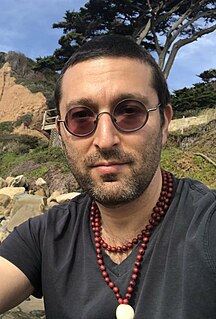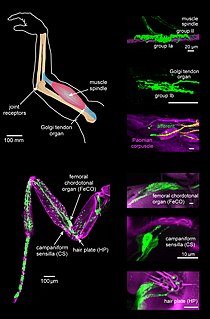Multimedia is content that uses a combination of different content forms such as text, audio, images, animations, video and interactive content. Multimedia contrasts with media that use only rudimentary computer displays such as text-only or traditional forms of printed or hand-produced material.
Interactive storytelling is a form of digital entertainment in which the storyline is not predetermined. The author creates the setting, characters, and situation which the narrative must address, but the user experiences a unique story based on their interactions with the story world. The architecture of an interactive storytelling program includes a drama manager, user model, and agent model to control, respectively, aspects of narrative production, player uniqueness, and character knowledge and behavior. Together, these systems generate characters that act "human," alter the world in real-time reactions to the player, and ensure that new narrative events unfold comprehensibly.

Scott Fisher is the Professor and Founding Chair of the Interactive Media Division in the USC School of Cinematic Arts at the University of Southern California, and Director of the Mobile and Environmental Media Lab there. He is an artist and technologist who has worked extensively on virtual reality, including pioneering work at NASA, Atari Research Labs, MIT's Architecture Machine Group and Keio University.
Digital storytelling is a short form of digital media production that allows everyday people to share aspects of their story. The media used may include the digital equivalent of film techniques, stills, audio only, or any of the other forms of non-physical media which individuals can use to tell a story or present an idea.
The USC Center for Visual Anthropology (CVA) is a center located at the University of Southern California. It is dedicated to the field of visual anthropology, incorporating visual modes of expression in the academic discipline of anthropology. It does so in conjunction with faculty in the anthropology department through five types of activities: training, research and analysis of visual culture, production of visual projects, archiving and collecting, and the sponsorship of conferences and film festivals. It offers a B.A. and an MVA in Visual Anthropology.

Alex McDowell, RDI is British narrative designer and creative director.

Ubuntu Studio is a recognized flavor of the Ubuntu Linux distribution, which is geared to general multimedia production. The original version, based on Ubuntu 7.04, was released on 10 May 2007.

Dan Goldman is an American writer, artist and producer living in Los Angeles. With a career spanning graphic novels, screenwriting, video games and augmented-reality, he is the creator of critically acclaimed works such as Shooting War, Red Light Properties and the Priya's Shakti series. He is the founder and Narrative Lead of the Los Angeles-based Kinjin Story Lab.
Vectors is a peer-reviewed online academic journal published by the USC School of Cinematic Arts. It was established in March 2005 and covers the digital humanities, publishing work that "cannot exist in print". Vectors is recognized as an experimental precursor to the digital humanities, producing and publishing a range of highly interactive works of multimedia scholarship. Comparing Vectors with more traditional digital humanities publications, Patrick Svensson notes that, "Vectors, on the other hand, is clearly invested in the digital as an expressive medium in an experimental and creative way.". The journal no longer actively produces projects or provides support to journal contributors but does accept completed submissions on a rolling basis. The editors-in-chief are Tara McPherson of the USC School of Cinematic Arts and Steve F. Anderson of the UCLA School of Theater, Film & Television.
Glogster is a cloud-based (SaaS) platform for creating presentations and interactive learning. A platform that allows users, mostly students and educators to combine text, images, video, and audio to create an interactive, Web-based poster called glogs on a virtual canvas. Glogster facilitates the conveyance of social information in many different fields such as art, music, photography. Users also have access to a library of engaging educational content posters created by other students and educators worldwide. Glogster enables interactive, collaborative education and digital literacy.
Created in 2013, Media Arts and Practice (MA+P) is the seventh degree-granting division of the USC School of Cinematic Arts.
Sharon Daniel is a professor in the Film and Digital Media department and serves as chair for the Digital Arts and New Media MFA program at the University of California, Santa Cruz. Along with teaching classes about digital media, Daniel does field research for new media projects. Her essays have been published in analytical and research journals such as Sarai and Leonardo. Selected projects of Daniel's have been presented at festivals including the Lincoln Center Festival, the Dutch Electronic Arts Festival, Ars Electronica, and the Corcoran Biennial. She has also received grants and support from various institutes and foundations. She is interested in public and community collaborations that give voices to those who are unable or reluctant to tell their stories.
Blue Velvet is an online digital history project about the city of New Orleans both before and after Hurricane Katrina. The project was published in the fifth issue of Vectors Journal of Culture and Technology in a Dynamic Vernacular, entitled "Difference." The full title of the project is "Blue Velvet: Redressing New Orleans in Katrina's Wake."
Craig Dietrich is a digital artist, scholar, and educator affiliated with Occidental College in Los Angeles.

Delta Kappa Alpha (ΔΚΑ) is a national gender-inclusive cinematic professional fraternity founded in 1936, at the School of Cinematic Arts at the University of Southern California in Los Angeles, California, United States.

Multimedia University is a private university in Malaysia. The university has three campuses, located in Melaka, Cyberjaya and Iskandar Puteri. The university hosts 9 faculties and 19 research centres.
Marsha Kinder is an American film scholar and Professor of Critical Studies at the University of Southern California.

Critical Commons is an online repository of user-generated media. The archive is a project of the Media Arts and Practice division of the USC School of Cinematic Arts. The project supports the fair use of copyrighted media by educators.
Steve F. Anderson is Professor of Digital Media at the UCLA School of Theater, Film and Television. Previously, he served as founding director of the Ph.D. program in Media Arts and Practice at the USC School of Cinematic Arts and an Associate Professor in the USC Interactive Media & Games Division. He co-edits the interdisciplinary electronic journal Vectors Journal of Culture and Technology in a Dynamic Vernacular and is the founder of Critical Commons, an online media archive and fair use advocacy network. He is author of the books Technologies of Vision: The War Between Data and Images and Technologies of History: Visual Media and the Eccentricity of the Past.
Exceptional Minds is the first American computer animation studio and non-profit digital arts school for young adults on the autism spectrum. It is located in Sherman Oaks, Los Angeles, California.











